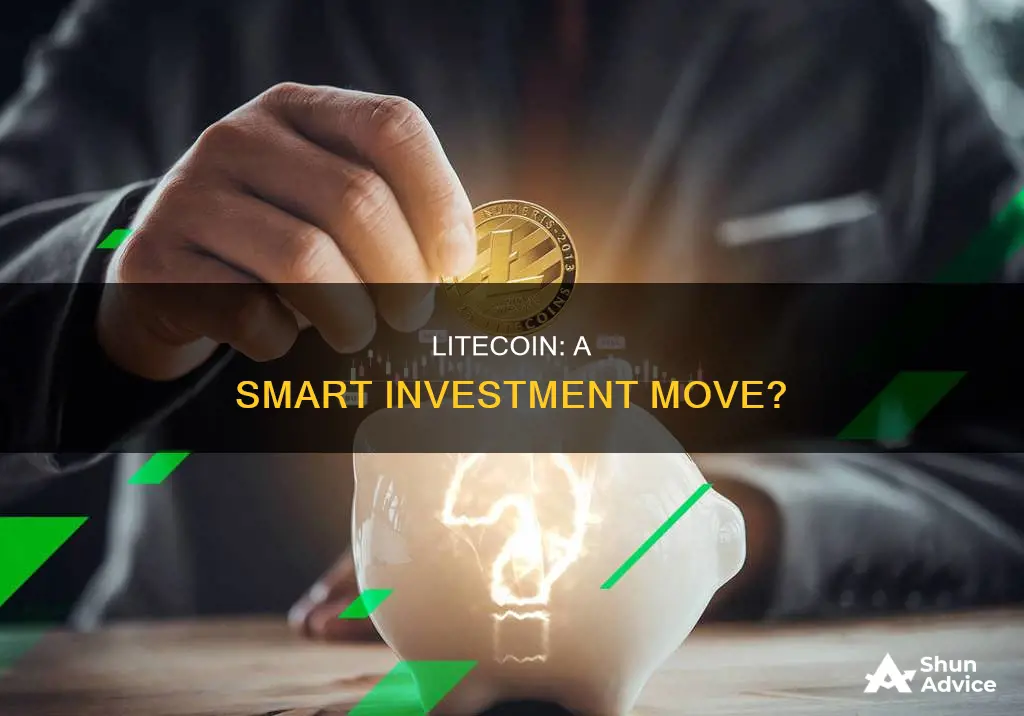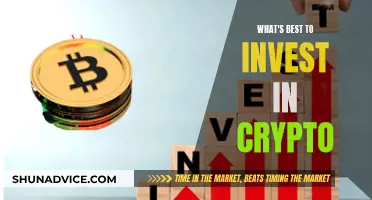
Litecoin is a peer-to-peer cryptocurrency that enables near-instant, low-cost payments to anyone in the world. It is an open-source, global payment network that is fully decentralised and secured by mathematics. In this article, we will explore the pros and cons of investing in Litecoin.
What You'll Learn

Litecoin's value and market capitalisation
Litecoin is a peer-to-peer cryptocurrency that was created by Charlie Lee, a former Google employee, in 2011. It was designed as a "lite version of Bitcoin" and is based on the Bitcoin protocol but differs in terms of the hashing algorithm used, hard cap, block transaction times, and a few other factors. Litecoin has a block time of 2.5 minutes, making it much faster than Bitcoin, and extremely low transaction fees, making it suitable for micro-transactions and point-of-sale payments.
Litecoin is one of the most prominent altcoins and has inspired many other alternative currencies, including Dogecoin, due to its use of the Scrypt hashing algorithm, which prevents ASIC miners from mining coins. As of January 2021, it is one of the most widely accepted cryptocurrencies, with over 2,000 merchants and stores accepting LTC worldwide.
Litecoin has a market cap of around $4.75 billion, ranking it at #19 on CoinMarketCap as of August 2024. Its market capitalization history has been volatile, with highs of $386.45 in May 2021 and lows of $2 to $4 in the years following its massive bull run in late 2013, which saw its price hit $44.73. Litecoin's price has also been affected by events such as the bear market and Mt. Gox hack in 2014, and the crypto bull market in late 2017.
Litecoin's value has seen significant growth since its early days. In June 2017, Litecoin was trading at around $40, and as of December 2021, its price had risen to above $160. As of August 2024, Litecoin's price is around $63 to $65, with a 24-hour trading volume of $238 million to $347 million. Its current price is significantly lower than its all-time high of $420.
Bitcoin Futures: A Smart Investment Move?
You may want to see also

How to buy Litecoin
Investing in cryptocurrencies like Litecoin can be a risky but rewarding endeavour. If you're looking to buy Litecoin, here's a step-by-step guide to help you get started:
Step 1: Choose a Crypto Exchange or Brokerage
The first step is to select a cryptocurrency exchange or brokerage platform that offers Litecoin. Popular options include Coinbase, Binance, Uphold, and BitPanda. These platforms provide an easy and secure way to buy, sell, and trade cryptocurrencies.
Step 2: Create an Account
Once you've chosen a platform, you'll need to create an account. This typically involves providing personal information such as your name, email address, and setting up a password. Some platforms may also require you to verify your identity by providing a valid ID and proof of address.
Step 3: Deposit Funds
After your account is set up, you'll need to deposit funds into your account. This can be done through various payment methods, including bank transfers, debit/credit cards, or even platforms like PayPal, depending on the platform and your location. Make sure to check the fees associated with each payment method, as they may vary.
Step 4: Buy Litecoin
Now you're ready to buy Litecoin! Simply search for Litecoin on the platform and specify the amount you want to purchase. The platform will typically provide a preview of your purchase, including the amount of Litecoin you will receive based on the current exchange rate. Review the details and confirm your purchase.
Step 5: Store Your Litecoin Securely
Once you've purchased Litecoin, consider storing it in a secure digital wallet. You can use the wallet provided by your exchange or transfer it to a third-party wallet. It is generally recommended to use a personal wallet to protect your investment and maintain control over your cryptocurrency.
Remember, investing in cryptocurrencies carries significant risks, and the market is highly volatile. Always do your own research, understand the risks involved, and invest only what you can afford to lose.
Who's Investing in Bitcoin? A Look at Ownership Statistics
You may want to see also

Litecoin's history
Litecoin (LTC) was launched on 13 October 2011 as an alternative cryptocurrency, or "the silver to Bitcoin's gold". It was created by former Google engineer and Massachusetts Institute of Technology graduate Charlie Lee, who had become interested in Bitcoin earlier that year.
Lee created Litecoin by forking the Bitcoin blockchain. He modified the code to include a decreased block generation time, an increased maximum number of coins, and a different hashing algorithm. Lee released Litecoin via an open-source client on GitHub on 7 October 2011, and the Litecoin network went live six days later.
In its early days, Litecoin's growth was aided by its increasing exchange availability and liquidity on early exchanges such as BTC-e. In November 2013, the aggregate value of Litecoin experienced massive growth, including a 100% leap within 24 hours. In 2014, Lee suggested that Dogecoin merge mine with Litecoin, which it did in September of that year.
In 2017, Lee left his role at Coinbase to pursue LTC's development full-time. He now serves as the managing director of the Litecoin Foundation, a non-profit dedicated to supporting the cryptocurrency. In December 2017, Lee revealed that he was selling and donating all of his LTC, as he was often accused of tweeting about the cryptocurrency for personal benefit. Litecoin was trading at an all-time high of around $350 at the time, and Lee's move was widely criticised.
In 2022, Litecoin added optional privacy features via a soft fork through the MWEB (MimbleWimble extension block) upgrade.
Bitcoin's Ethical Investment: Exploring the Moral Minefield
You may want to see also

Litecoin's technology
Litecoin is a peer-to-peer internet currency that enables instant, near-zero-cost payments to anyone in the world. It is an open-source, global payment network that is fully decentralised. Mathematics secures the network and empowers individuals to control their finances.
Litecoin is different from other currencies in a few key ways. Firstly, unlike Bitcoin and Ethereum, Litecoin uses a software algorithm (Scrypt) to mine units. This prevents individuals from making powerful custom computers (or rigs) to mine the currency. Secondly, Litecoin has one of the fastest transaction times among digital currencies, at 2.5 minutes, compared to Bitcoin's 10 minutes. Thirdly, Litecoin is the cheapest of the three major cryptocurrencies. As of June 2017, Litecoin was trading at around $40, compared to Bitcoin's $2,500 and Ethereum's $300.
When investing in Litecoin, it is important to remember that it is a currency, not a stock or bond. This means that instead of buying shares, you are swapping your currency for Litecoin. For example, $1 USD is equal to about $163 in Litecoin. The goal is for the value of Litecoin to rise so that you can exchange your Litecoins back into dollars.
Exploring Bitcoin City: El Salvador's Crypto Investment
You may want to see also

Litecoin's future potential
Litecoin has been a prominent player in the world of cryptocurrencies, alongside Bitcoin and Ethereum. It has unique features and an established position in the market, making it an intriguing investment opportunity. Here are some factors that highlight Litecoin's future potential:
- Improved Version of Bitcoin: Litecoin is often referred to as the "Silver to Bitcoin's Gold" or the "Dark Horse of 2018". It is built on the source code of Bitcoin but with improvements. Litecoin addresses the issue of transaction time, processing transactions faster than Bitcoin.
- Experienced Founder: Litecoin was founded by Charlie Lee, a former software engineer at Google and Coinbase. Lee's experience and connections in the crypto space give investors confidence in the digital currency's future.
- Merchant Integrations: Litecoin has partnered with LitePay, GoCoin, Globee, Coin Payments, BitcoinPay, and BTCPay. These integrations increase merchant adoption and make it easier for businesses to accept Litecoin payments.
- Lightning Network: The Lightning Network is a technology upgrade that allows transactions to process at high speeds, making it ideal for instant micro-transactions. This upgrade will further enhance Litecoin's transaction speed.
- Great Store of Value: Litecoin has the potential to be widely adopted due to its use in the retail industry, and its value has been increasing over the years.
- Cheaper and Easier to Mine: Litecoin mining is cheaper and less processor-intensive than Bitcoin mining, encouraging more people to mine Litecoin and earn profits.
- Strong Market Capitalization: Litecoin is consistently ranked among the top cryptocurrencies in terms of market capitalization. It has a large supply of 84 million coins, four times that of Bitcoin.
- Historical Performance: Litecoin has shown impressive growth since its inception in 2011. It reached a market capitalization of $1 billion in 2013 and recorded its highest price of $372 in December 2017.
- Positive Analyst Outlook: Analysts predict that Litecoin will reach fresh highs in the future, with its price expected to increase significantly.
While there are risks and volatility associated with investing in cryptocurrencies, Litecoin has demonstrated strong fundamentals and future potential. It has a solid technical foundation, a dedicated team, and growing merchant adoption. These factors contribute to the positive outlook for Litecoin's future performance and potential for growth.
Grayscale Bitcoin Trust: What's the Investment Focus?
You may want to see also
Frequently asked questions
Litecoin is a peer-to-peer internet currency that enables instant, near-zero-cost payments to anyone in the world. It is an open-source, global payment network that is fully decentralised. Litecoin was founded in October 2011 and was one of the earliest Bitcoin spinoffs.
Litecoin is one of the top cryptocurrencies in market capitalisation. It is like Bitcoin but improved, with faster transaction times and lower fees. It is also cheaper and easier to mine than Bitcoin.
As with any cryptocurrency, there is a high degree of risk involved in investing in Litecoin. Its volatile price gyrations undermine its credibility as a currency, and there is a risk that governments will eventually crack down on cryptocurrencies and regulate them.







